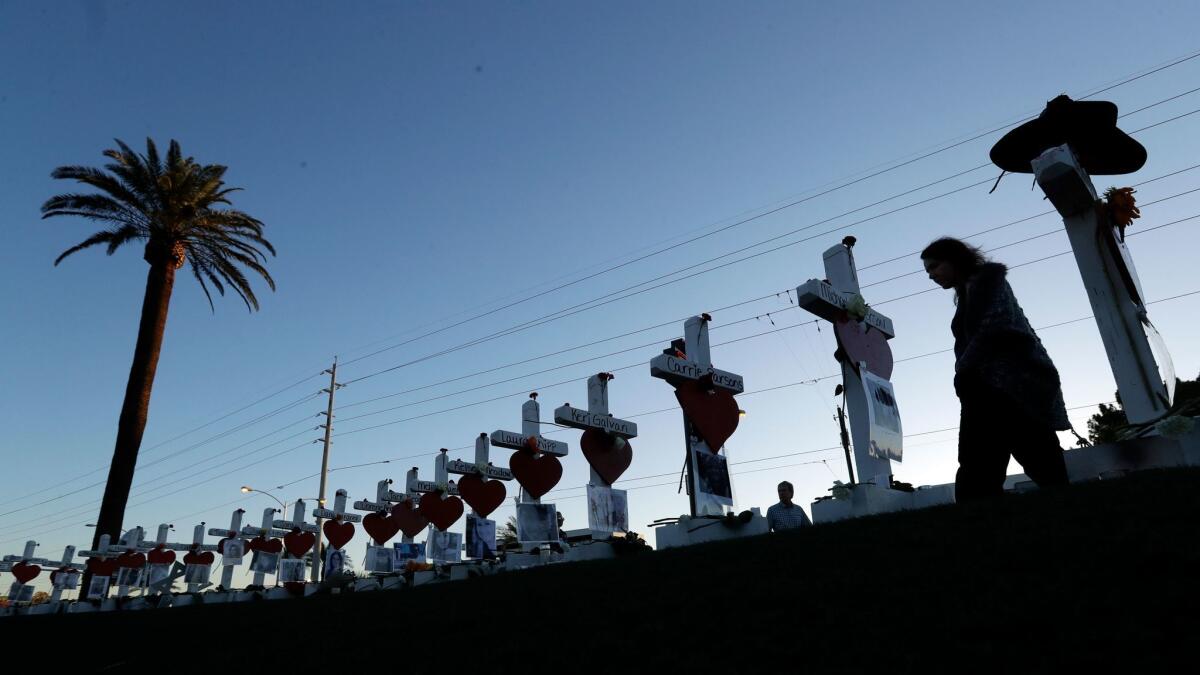Compassion fatigue? Donations following Las Vegas massacre lag behind other victims funds

- Share via
Reporting from Las Vegas — She’s jumpy, sitting outside the Starbucks on a bright morning in an upscale Las Vegas neighborhood. People walk by, and she watches most of them closely. A helicopter flying toward the Las Vegas Strip causes her to jerk her head upward. She stops talking.
“Helicopters are a trigger,” Christine Caria said.
The 49-year-old Las Vegas resident said she is living with post-traumatic stress disorder, torn leg ligaments and a wrenched back after being trampled amid the mass shooting on Oct. 1. Stephen Paddock, stationed on the 32nd floor of the Mandalay Bay Resort and Casino, fired on an open-air concert attended by about 22,000 people that night, killing 58 and injuring hundreds of others.
Caria is one of thousands who likely won’t be eligible for funds collected by the Las Vegas Victims Fund.
Scott Nielsen, chairman of the Las Vegas Victims Fund Committee, said the size of the victim pool, coupled with the amount raised, about $16 million, will make it difficult for everyone to get what is needed.
“When we had our town hall meetings and listened to the survivors, they told us very touching stories and heartfelt stories about not being able to go back to what they were doing before,” Nielsen said. “It’s cost them jobs, their apartments, relationships, and the problem is trying to financially help those people because there are so many of them.”
After past tragedies, such as the 2012 movie theater massacre in Aurora, Colo., the process of distributing monetary gifts to victims has been open to criticism. The Las Vegas shooting presents a unique problem: a massive victim pool with contributions coming in far below donations made for attacks such as those in Boston and Orlando, Fla.
The Las Vegas Victims Fund Committee on Friday is expected to finalize the criteria for those who will qualify for cash disbursements — with critics asking for a delay to see whether more money can be raised to get more victims covered.
Nielsen noted a separate fund formed largely by the casino industry — the Vegas Strong Fund — has about $13 million in donations, and a yet-to-be-determined portion of that amount eventually will end up in the Las Vegas Victims Fund.
Jennifer Holub, a 38-year-old from Utah who said she was at the concert, said she suffers from severe PTSD. Her physical injuries include a dislocated shoulder, rib and thumb, and she is going to a chiropractor. Her trauma therapist is an hour’s drive away and, as a small business owner, those sessions aren’t covered by insurance. She also said more money needs to be raised to help everyone without getting into “a competition of injuries.”
“We all have different relationships, different support systems, different insurance coverages,” she said. “You can say you can see someone’s gunshot wound, but you can’t see my nightmares. All Las Vegas victims matter, and everyone deserves some help.”
You can say you can see someone’s gunshot wound, but you can’t see my nightmares. All Las Vegas victims matter, and everyone deserves some help.
— Jennifer Holub
Ken Feinberg, an expert on disaster funds and a consultant to the Las Vegas fund, said that’s not possible.
“PTSD is a very legitimate injury, but there’s not enough money,” said Feinberg, who oversaw fund disbursement after the Pulse nightclub shooting in Orlando and the Boston Marathon bombing.
“You’re talking about thousands of people,” he said. “Do you know how long it would take to process claims where the allegation is PTSD? It would tie up the fund in knots in terms of speed and efficiency.”
Under the current protocols, the highest level of payment would go to death claims, victims who suffered permanent brain damage or paralysis and those who require continuous home medical assistance.
The second category would be those who were admitted to a hospital within the first 48 hours and spent more than one night in a hospital between Oct. 1 and Jan. 31, 2018.
By comparison, the One Orlando fund, did allow people who were in the nightclub to make a claim even if they didn’t suffer a physical injury requiring treatment. However, that category was the lowest priority behind those who died, were severely injured or required hospitalization.
Last year’s shooting in Orlando, where 49 people were killed and nearly 60 injured, resulted in $27 million in cash disbursements. More than $17 million was distributed to families of those who died. Those who spent time in a hospital were given between $65,000 and $300,000. Of the people in the lowest category — those who were present at the nightclub but weren’t hospitalized — 186 each got $25,000.
The fund for the Boston Marathon bombing in 2013 eclipsed $80 million. In that blast, three people were killed and hundreds were injured, including many who lost limbs. The Arrowhead United Way’s fund for the San Bernardino shooting that left 14 dead and 24 injured had $2.4 million to distribute to victims of the 2015 attack.
In San Bernardino, families of those who died were eligible for about $140,000 and the 24 injured were eligible for $5,000 plus $1,000 for each night spent in the hospital. For the 37 present during the shooting, each was eligible for $2,993.
Several fundraising experts said the Las Vegas collection may trail other donation efforts for several reasons, including “compassion fatigue,” the ongoing mystery surrounding the shooter’s motive and the timing of the massacre.
Sandy Rees, who has 20 years of experience fundraising and runs Get Fully Funded from its headquarters in Tennessee, said that in recent months, people also gave money to help victims of the hurricanes that hit Texas, Florida and Puerto Rico. There also were fires that swept through Northern California and a mass shooting at a church in Texas.
“Compassion fatigue is a real thing. There have been so many things that happened this year,” Rees said. “But it does get overwhelming, and I think people start to tune out.”
She also said that with 22,000 concertgoers, 58 dead and more than 500 wounded, the numbers in Las Vegas obscure the individual tragedies. Donors, she said, respond to personal stories.
“Fundraising is an emotional act. We do it with our heart and reinforce it with our head. You have to tell a story about one person or one family and why that matters,” Rees said. “You talk about large numbers in need, people are more likely to glaze over and tune out.”
Larry C. Johnson, a Boise, Idaho-based fundraising consultant who runs the Eight Principles, said he thinks the Las Vegas shooting remains shrouded in mystery and has allowed conspiracy theories to bloom — something that makes giving less attractive to donors.
“Yes, it’s clear people died and were injured, but there is not clarity of resolution,” Johnson said. “The hurricane happens, and you see rebuilding. In Vegas, there is a sense of still waiting.”
The Las Vegas Victims Fund will keep taking donations through at least Jan. 31 — and possibly beyond — but fundraising experts agree that the bulk of giving occurs in the first six weeks after a tragedy.
The Las Vegas fund didn’t receive nonprofit status from the Internal Revenue Service until the end of November — about eight weeks after the mass shooting.
Nielsen said Clark County, Nev., didn’t have a way to accept donations as a nonprofit. Instead, he said, the National Compassion Fund set up web page for people and companies to give to the Las Vegas shooting victims and have those donations be tax-deductible.
Twitter: @davemontero
ALSO
In Alabama and across the country, pride swells as black female voters show they matter
Obamacare sign-ups quicken as final enrollment deadline approaches in many states
Kentucky state lawmaker kills himself following molestation allegation
More to Read
Sign up for Essential California
The most important California stories and recommendations in your inbox every morning.
You may occasionally receive promotional content from the Los Angeles Times.














